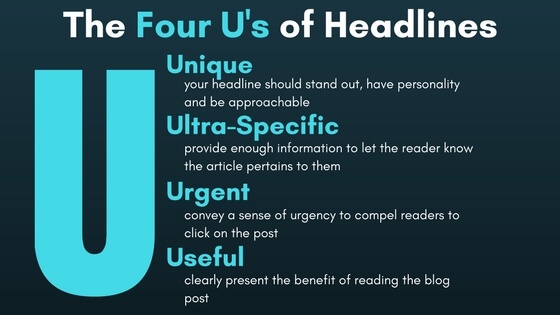You’ve got a business blog with content that has all of the right keywords in place, but something seems amiss. The traffic to your site is steady, but visitors aren’t sticking around or clicking on other pages. If this describes your situation, it’s time to get serious about audience engagement.
Audience engagement is an important part of having a successful business blog. And in this post, we'll show you a variety of ways to improve audience engagement with your blog, including retooling your site, adjusting your content creation and promoting your blog posts through social media.
How Do You Measure Audience Engagement?
Engagement is important when it comes to content marketing because if you're paying attention to it, it can result in unbelievable dividends to help your business grow. Marketer Jason Amunwa says, "blog post engagement is a huge and powerful concept that's intimidating to consider as a whole – but it's really made up of smaller, simpler components that are pretty simple to understand."
These "smaller, simpler components" can be easily overlooked, but here are a few of the most common items:
- Comments – Take a look at the comments section on your blog to see what types of feedback you're receiving. If you're getting a lot of constructive responses and questions, it shows that your readers are attentive.
- Social Shares – Are your posts being shared and retweeted repeatedly on social media? This is a good indicator that your audience finds your content credible and valuable, as they are taking the extra time to share it with friends, colleagues and peers.
- Time on Page – By monitoring how long readers spend on your page, you can gauge whether they're just checking out the headline or thoroughly reading the entire post.
- Scroll Maps – While the time spent on a page is a helpful metric, scroll maps allow you to see whether readers are actually reading your post. If you see that readers are moving down the page, you'll know they're taking in your content versus tabbing it for later reading while they walk away to get a cup of coffee.
- Inbound Links – Are you seeing traffic arriving to your site from other blogs and websites? This means you're attracting more inbound links because other bloggers and writers view your work as valuable.
- Click-Through Rates (CTR)– Being able to attract readers to your site is one thing, but keeping them around is another. Tracking the click-through rates to other pages on your site will indicate that readers are sticking around to check out your other content and services.
- Conversions – This may not take effect right away, but experiencing conversions from readers to customers is a definitive sign of positive audience engagement.
Now that you have some tools for measuring audience engagement, let’s talk about what you need to know about your business blog before you start measuring anything.
Determine Your Objectives and Understand Your Buyer Personas
Before you begin to measure audience engagement, you should determine what objectives you have for your business blog. Are you looking to build credibility and authority in your industry? Is the goal to improve brand awareness? Perhaps you have a specific goal of driving a 20% increase in online sales. Whatever you want to accomplish with your business blog, it should be written down and kept in mind so that you can decide exactly how to measure the effectiveness of your efforts and tailor your content creation in the future.
It’s also imperative to know what content works and what doesn't with your target audience. With a clear understanding of your buyers, you'll be able to fine-tune your objectives and easily craft engaging content that will appeal to your readers. This is why buyer personas are one of the most important tools to have in your blogging tool box. Buyer personas help you understand what your customers value, what their interests are and other important demographics. By crafting a buyer persona, you'll get a picture of your audience, which will make conveying your message easier.

16 Tips for Improving Audience Engagement with Your Blog
Once you know your objectives for your business blog and have a keen understanding of who your customers are, there are several ways you can amp up your content and give visitors to your blog an experience that will invite them to engage and return to your blog on a regular basis. Here are 16 tips for creating great content and a stellar user experience.
1. Clear Out the Clutter on Your Business Blog
How many times have you read a headline for an article online, only to click on the link and discover a site that is overrun with ads, is incredibly slow and requires you to click on multiple pages to keep reading the article? It's frustrating, right? Did you leave the site without even finding out the information you were promised?
Now, look at your own blog. Do you see similar issues? It's time to get out the digital vacuum and do some housekeeping.

Just like shopping in a store or eating at a restaurant, readers are more likely to return to your blog if their experience is an enjoyable one. An easy way to make this happen is by simplifying the layout and look of your site. We're not saying that your site needs an entire overhaul, but some simple changes can make a huge difference.
- Get rid of unnecessary badges and widgets – If it’s not helpful, get rid of it.
- Review ads – Check on the performance of the ads that are on your website, and remove those that aren't performing up to your standards or don't pertain to your audience.
- Mend broken links – Make sure the links on your pages lead to the right location, and adjust them if necessary.
- Boost page load times – In this instant culture, waiting more than a few seconds for a page to load can result in the reader abandoning their original purpose.
By getting in touch with your website developer and starting with these simple changes, your blog will start to look dramatically better and your audience will thank you.
2. Make Your Point Clearly
Another way to improve the user experience is to ensure your message is clear. No one wants to read a 4,000-word blog post that is filled with inconsistencies. People come to your blog with an issue and are seeking a solution – it’s your job to give them the solution they need. Your main message should be in the headline and within the first few lines of the post so that readers will know the post is what they're looking for.
3. Give Readers the Structure They Crave
When buildings are constructed, the contractors establish a solid foundation and frame to ensure the edifice remains standing. If they were to start with trying to create a Wi-Fi connection or making the drywall stand up on its own, the building would collapse like a house of cards.
Building a blog post is very similar; by establishing structure from the beginning, your post will be set up for success. An easy way to do this is by drafting an outline of what you're aiming to talk about, so your thoughts are manageable and organized in a logical order. Plus, as you're writing the post, you'll be more productive and have the ability to flex your creative muscles.
Writing your blog posts in a logical way also gives your readers a path to follow, so they'll arrive at the end feeling satisfied. But delivering your information in a logical way isn't the only structural solution, as it also helps to have the message conveyed in an attractive way.
Break up large chunks of text into separate paragraphs to make your content more visually appealing. The use of whitespace on the screen makes it easier for our brains to process and consume new information. If there's a large amount of text on a page in a giant chunk, it can be tough to read and dizzying to comprehend. Information overload is not an ideal way to engage your readers.
Use the whitespace on the screen to separate thoughts and allow readers to stop and take notice of certain elements on your site.

4. Catch Attention with Your Headlines
Everywhere you turn on the Internet, you're bound to see dozens of different headlines trying to entice you to click on the link. Photos of celebrities performing tasks "just like us", lists of items from your past to make you reminisce and quizzes to see what candy bar fits your personality are just some examples.
The catch is that studies show 80% of readers will never go past the headline. And to that effect, traffic can change as much as 500% depending upon the headline you use.
Your headlines should be entertaining, intriguing and aim to draw in readers. However, make sure your titles are crafted to make a promise that your blog post will deliver on. Your readers don't want to feel tricked after reading your content, especially if they are looking for a solution to a particular problem.
Expert writers, including Neil Patel and Joseph Putnam, often use the four U's of headline construction – Unique, Ultra-Specific, Urgent and Useful – to ensure they’re creating headlines that work. As the graphic below lays out, your headlines should be unique enough to grab the reader’s attention, provide enough specific information to let the reader know the article is of interest to them, convey a sense of urgency so that the reader will click on the post and clearly present the reader with the benefit they will receive from reading the post.

5. Hook Readers with Your Introduction
Star Wars: A New Hope has one of the most iconic introductions of all time. The legendary music and the text crawl set against the blackness of space is followed by a small ship making its getaway and being pursued by a seemingly endless Star Destroyer that fills the screen. From that moment, the audience is hooked and wants to know what happens next.
The introductions to your blog posts should have a well-crafted hook, too. Your headline drew the readers in enough to click on the link, but why should they stay and read on? Here are a couple of ways you can hook a reader.
- Deliver an interesting or unfamiliar fact that intrigues the reader.
- Convey a short anecdote that the reader can identify with. If they're looking for a solution to an issue and your blog identifies that need, they're bound to continue reading.
- Put forth a question that your readers will want to find out the answer to by reading on.
- Tell the conclusion to a story with the happy ending, and then use the blog post to explain how you arrived at that point.
- Gently confront the reader about something they should or shouldn’t be doing before using the blog post to convey your message.
6. Create Content That’s Approachable
Don't be afraid to inject yourself into your writing. Your readers aren't just looking to buy your products, they want to believe in what you're saying. And the easiest way to do that is to make your content genuine and authentic. By writing in the 1st- or 2nd-person point-of-view, you'll connect with your readers in a way that makes them feel like you actually care. While the 3rd-person perspective has its merits, it tends to come across as robotic or formulaic in blog posts, and you want your content to read like a conversation between friends or colleagues.
7. Establish Your Credibility with Data and External Links
When you're including detailed information and statistics to illustrate your points, you need to show your readers the data to back up those claims. This will only add to your credibility and expertise in the area. This use of data can encourage others to link to your site as well.
You can also establish credibility with links to external sites, as well as links to posts on your own site. Your readers will appreciate knowing where you found your information, and will enjoy reading further on the topic you just introduced.
8. Call On the Advice of Industry Experts
Adding thoughts, quotes or paraphrasing experts in your field can also help enhance the credibility of your posts. Including this type of content shows your readers that you've done the legwork and truly know your stuff. You can also ask experts to write a guest post for your blog, as having them lend their expertise to a topic will help your site rank higher on the Search Engine Results Page (SERP).
9. Put in Your Two Cents on Industry Trends and Newsworthy Topics
No matter what business you're in, it's crucial to stay competitive by staying on top of industry trends. Your audience will likely appreciate it if you put new rules, industry changes and the latest trends into context for them.
And writing blog posts regarding newsworthy topics can help extend your reach to attract more visitors. By using your blog posts to comment on important issues, tying the news of the day to your audience’s needs and interests, you can take advantage of what “everyone” is talking about in the moment.

10. Use Graphics, Images and Videos to Add Visual Storytelling
It’s been shown that adding visual elements and graphics to your blog posts generates up to 94% more views. The power of adding visual storytelling to your blog posts cannot be overstated.
By adding attractive infographics or data tables, you can convey detailed statistics in an appealing manner that will be easier for readers to digest. Photos also add an enhancement to your posts and help break up the content, which makes it easier for your message to be consumed. And don't forget about videos. Videos have been shown to attract 3 times as many inbound links as plain-text posts.
11. Try Podcasts to Engage with Auditory Learners
While a majority of people take in and retain information easily through visual formats, nearly one-third of individuals are auditory learners. And with the popularity of podcasts exploding, they’re one more format you should consider adding to your blog to help engage your audience. With a podcast, visitors can listen to your content during their commute or while performing tasks around their home or office.
12. Ask Your Readers to Engage
At the end of your post, encourage readers to comment on your content. This can foster a discussion about items brought up in the article or even offer a chance for conversion. Make sure to respond in a timely fashion to comments, as this will build a relationship with your readers.
Ask your audience to like and share your articles on LinkedIn and Facebook, like posts on Instagram and retweet your content on Twitter. If they've finished reading your piece of content and they enjoyed it, simply pressing a button to spread your message to their social network is a no-brainer.
Whether you're encouraging comments, shares or asking the reader to check out your business services, there should be a call-to-action (CTA) in the conclusion.
13. Engage with Your Audience on Social Media
Don’t just ask your readers to engage with you. Go online where they spend their digital time and engage with them first.
You can enter sub-reddits, forums and online communities to offer advice, answer questions and propose solutions to create a presence as an expert in your field. Plus, by including your website in your profile's signature or referencing it when giving a solution, readers will be able to easily find your site to check out more of your content.
14. Publish Your Content on a Consistent Basis
An easy way to improve audience engagement, as well as boost your site's ranking on Google, is to publish content on a consistent basis. "How often?" you might ask. It really depends on a number of factors, such as what your competition is doing, your capacity to create content and how fast your audience likes to consume content.
You don't want to overwhelm your audience with information, but at the same time, you want to make sure you're staying in their mind and remaining relevant. Finding that sweet spot of how often to publish may take some practice, but once you nail it down, stick to it to see promising results.

15. Promote Your Business Blog Posts
Taking time out of your busy day to promote your content may feel tedious, but it can be one of the most rewarding tasks you do. Thanks to your buyer personas, you know exactly who your target audience is and how to craft a message on social media that will draw in readers. It doesn't take long, but sharing and tweeting out a link to your blog post is a very easy way to encourage audience engagement.
And don't forget to send an email to your followers letting them know your new content is available. Just be sure your message is worthy of clicks. Sarah Cobb at HubSpot notes, "There is a fine line between invasive junk-email and a helpful newsletter, and that line is largely controlled by context." The subject line of your email should be crafted in the same vein as writing a headline for the post. It should be engaging without going so over the top that it does a disservice to your content.
16. Refresh and Renew Your Content
Finally, if you’ve got great content that you’ve posted in the past, don’t forget to update it to fit the times, and then promote it again. Simply repurposing some of your well-performing posts from the past can generate new views, likes and shares. And why wouldn't you want to bring out some of your greatest hits if they still ring true?
You can also create new content that brings together the work you’ve done in the past into a new format, such as an ebook. This repurposing of old blog posts can save you time and effort and give your blog a boost.
Conclusion
Thank you for staying engaged with this post, as we understand how important your time is, too. Now you have the information and pointers needed to transform your blog and receive the engagement you desire from your audience. Please comment below on any tips of your own, and feel free to share this post to boost engagement with your own audience.
If you're wondering how Virtucom Group can help you improve your audience engagement, contact us to request a free 30-minute consultation with one of our content experts.






